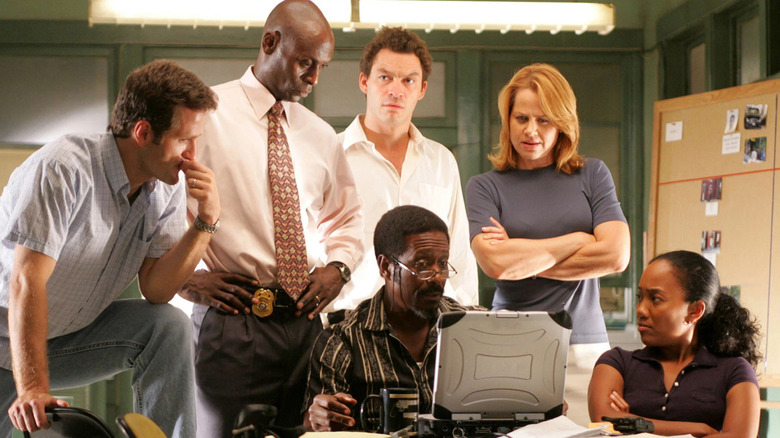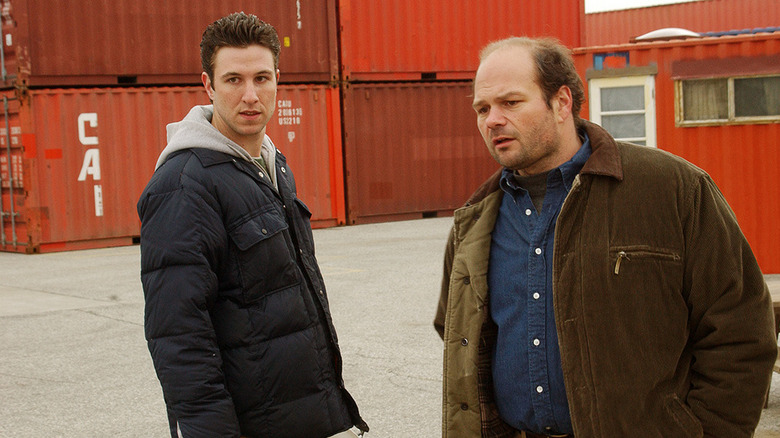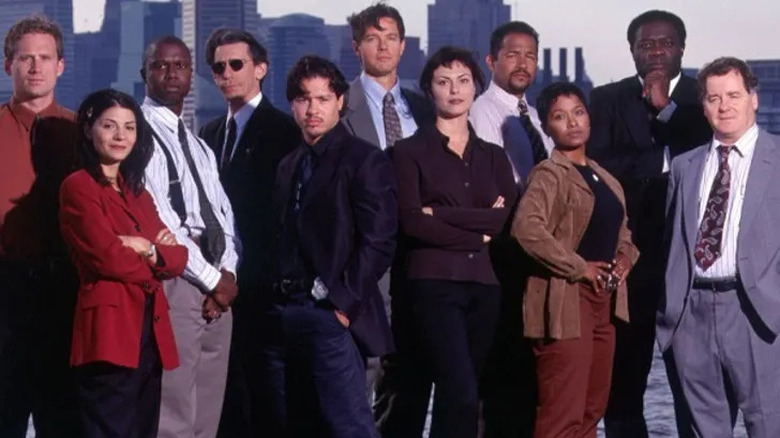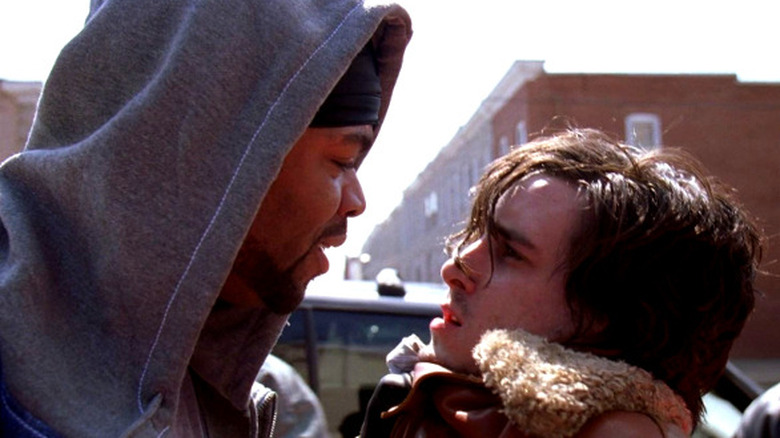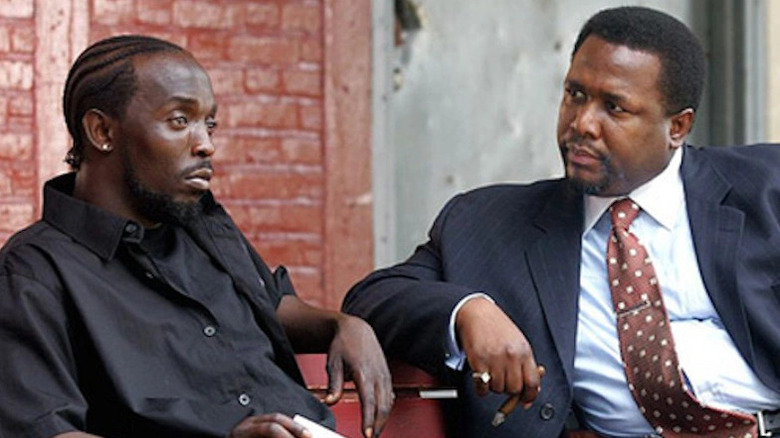Fans Weren't The Only People Put Off By The Wire's Seasonal Whiplash
Over its five seasons in the early aughts, David Simon's HBO series "The Wire" threw viewers off every now and then. The creator originally sold the show to HBO CEO Chris Albrecht and entertainment division president Carolyn Strauss as an inverted cop-and-criminal drama – one that broadened the horizons of Simon's previous Emmy-winning HBO series, itself an adaptation of his 1997 book co-written with homicide detective Ed Burns.
In print and on screen, "The Corner" cast an exasperated glare over the war on drugs, showcasing its failure through the distilled microcosm of a destitute Baltimore family — what "The Corner" director Charles S. Dutton calls, "a corner not too far from here, a corner like thousands of others across the country." Pulling upward and outward from that corner's realm, "The Wire" aimed to capture all of the angles and nuances that "The Corner" could not — from the lawmen who find themselves swimming against the tide to effect any real change, to drug dealers battling outdated criminal codes, all the way up to the boundaries of city hall and the Baltimore docks.
Beyond the wiretapping surveillance that the show's title implies, the first season of "The Wire" holds its spotlight on illicit drug running through the Barksdale organization, an empire ruled over by Avon Barksdale (Wood Harris) and his business-savvy right hand man Stringer Bell (Idris Elba). Over its initial thirteen episodes, audiences gained fluency in the world they were unceremoniously dropped into — the street language, the cadence, the lack of flashbacks, and the harrowing realism it all serves — only for the showrunners to begin the following season in an entirely new classroom, a move that shocked both fans and cast members alike.
'What the f*** is this? What happened to our drugs?'
Looking back for The Guardian, Dorian Lynskey's 10-year retrospective on "The Wire" highlights behind-the-scenes misgivings about the show's oscillating direction from season to season, through Clarke Peters (one of a handful of carry-overs from "The Corner"), who plays Det. Lester Freamon:
"I thought: 'What the f*** is this? What happened to our drugs?' For me, it was a way of saying: this isn't about you. This is about the city of Baltimore. It was necessary."
The late Michael K. Williams, whose code-honoring stickup artist Omar Little became one of television's most iconic characters, had similar thoughts:
"I was really psyched. I was hooked. I went down to Baltimore, fell in love with the city and I fell in love with the cast, the writing. I was ready for the second season. I was like, 'Where does the storyline go?' And I got introduced to the mind of David Simon! And he took it to the docks. And I got real bitter. I was an angry black man. And I approached David, and I was like, 'How come we make the show hot, and you give it to the white people?' He looked at me with patience in his eyes and he said, 'Trust me, if we go right back to the projects, we're going to make the story that we're building here way too small.' That went way over my f****** head. It wasn't until season 3 that things started to click."
Both cast members came around to Simon's vision once the plot path gave way to the series' larger orbit: the main character was neither Barksdale nor any of the detectives sniffing around his buildings, it was broader than that. The main character was Baltimore itself, and its slow death.
From street corner to cityscape
Simon knew from experience that chronicling the failure of the war on drugs required strong peripheral vision. In 1984 Simon, a young Baltimore Sun reporter, linked up with Ed Burns, then a homicide detective with the Baltimore Police Department who had just come to the conclusion of a sweeping wiretap investigation involving high-level drug trafficker Melvin Williams (who would later serve as an inspiration for Avon Barksdale and appear on the show as a modest deacon).
The two began a relationship that would later run through "The Wire" and beyond, but in the beginning Burns was a reliable source for Simon's writing. From a year-long self-installment alongside the BPD homicide unit came Simon's 1991 book "Homicide: A Year on the Killing Streets," adapted in 1993 into NBC series "Homicide: Life on the Street." Simon found himself on the writing staff of the show, its success opening the door to a pitch to adapt his 1997 book "The Corner: A Year in the Life of An Inner-City Neighborhood," co-written with Burns.
Simon's vision for "The Wire:" a long-running series, longer than the six parts that "The Corner" afforded, which would use a drug corner as its nexus before burgeoning into an epic project that interrogates the many failed systems at play in the "colossal waste of time and money" that encompassed the drug war. A proper cross-examination had to unpack not just the cops and dealers, but the supply routes, the nearsighted political machine, and the Swiss-cheese educational system. The show's narrative didn't call for a pivot, but a mushroom of scope.
'Now we're going to build a city'
By the time "The Wire" season 2 begins, Stringer Bell is still loose and in charge of operations for the Barksdale crew. Rather than get the lawman band back together in pursuit of him, Detective Jimmy McNulty (Dominic West), Lieutenant Cedric Daniels (Lance Reddick), and most of their detail are relegated to the sidelines. Instead, the lens pans over to the Port of Baltimore as the locus of a dying American city. Barksdale's people have been replaced by the laborers of the docks, a move Alan Sepinwall describes in his book "The Revolution Was Televised" as "the most important move the series ever made."
Through the likes of union leader Frank Sobotka (Chris Bauer), his judicious nephew Nick (Pablo Schreiber), and perennial screw-up Ziggy (James Ransone), the show's new POV was another microcosm of the drug conflict but, like the cumulative effect of the episodes themselves, amassed into something greater, earning the authority to pass condemnation to all institutions involved but few of its individuals. "Part of the game," the show's professed maxim goes.
Sepinwall's book reports on Simon's headspace on the eve of season 2:
"When they asked us what we were going to do if we came back, I said, 'Now we're going to build a city.' I remember going to Ed (Burns) and saying, 'The next season has to be about the working class and the death of work.' By making the death of work a part of the dynamic, it's no longer about the bad guys deciding they're going to be drug dealers because they're evil, it's about economic imperative."
Without the unfurling into other city systems at play in this great American decay, Simon argues, "It would be a cop show," and nothing more.
From 2002 to 2022
The second season departure paid off in higher ratings than the first; asked to account for it, Carolyn Strauss told Sepinwall:
"There is a theory at HBO that it satisfied an audience in the first season that we weren't satisfying with other programming. That second season may have overlapped with another audience we were satisfying somewhere else, and we may have lost some of that original audience in the process."
Producer Chris Albrecht was more succinct: "Because there were white people in it."
The perspective shift didn't end at the docks. "The Wire" season 3 sees McNulty and the BPD gang reassemble to pursue Stringer again, but it wasn't a safe return to the old formula. Now, the inquiries intersperse into a larger, more bleak arc. An entire thread surrounds a cop-led scheme of compromise, to restrict decriminalized drug sales to a region known as "Hamsterdam," a move that benefits the brass up until it's time to commit. Even Stringer tries to reform the "game" as the pushers play it, with disastrous results.
The fourth season moves the show's nerve center to the Baltimore school system; familiar characters like season 1's Roland "Prez" Pryzbylewski (Jim True-Frost) return for the Sisyphean task of reforming a busted system, but happy endings come sparsely for its children — an echo of Simon's goal to point out the "economic imperative" behind the most dismissed pawns in the game. The fifth and final season looked into the lens itself, scrutinizing media reportage of the entire mess and its shoddy communication with the public.
The cumulative effect of the show gave it resonance, leavened by characters given more depth than they had in previous procedurals and crime series. Simon had succeeded: twenty years after its pilot episode, "The Wire" is far more than just a cop show.
